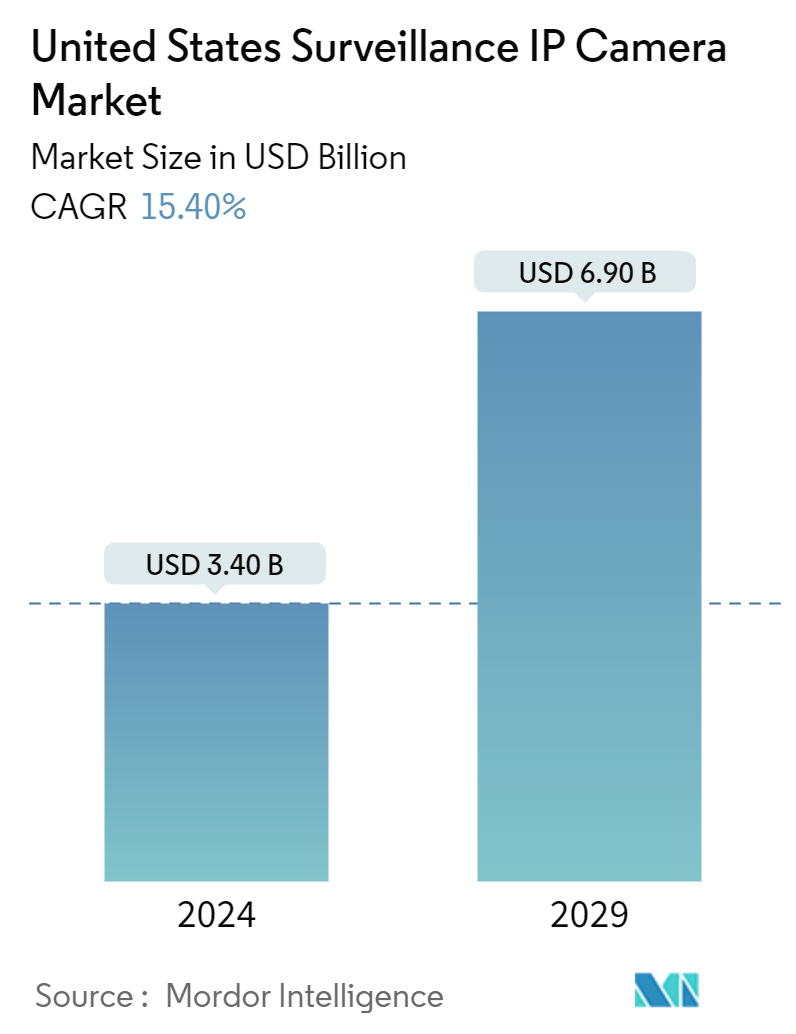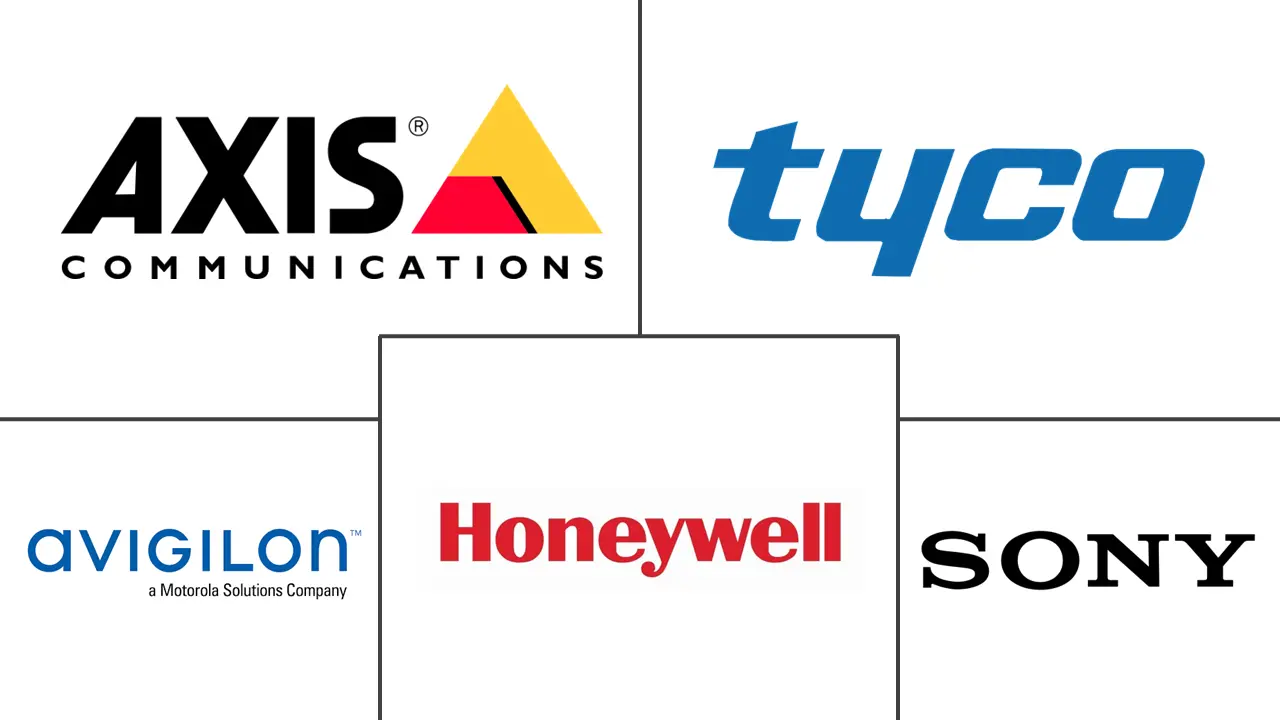Market Size of United States Surveillance IP Camera Industry

| Study Period | 2019 - 2029 |
| Base Year For Estimation | 2023 |
| Market Size (2024) | USD 3.40 Billion |
| Market Size (2029) | USD 6.90 Billion |
| CAGR (2024 - 2029) | 15.40 % |
| Market Concentration | Low |
Major Players
*Disclaimer: Major Players sorted in no particular order |
United States Surveillance IP Camera Market Analysis
The United States Surveillance IP Camera Market size is estimated at USD 3.40 billion in 2024, and is expected to reach USD 6.90 billion by 2029, growing at a CAGR of 15.40% during the forecast period (2024-2029).
- As numerous analog CCTV systems in the United States near the end of their operational life, the demand for their replacement with IP-based surveillance cameras is surging. IP cameras boast superior features, including heightened video resolution, enhanced image quality, remote accessibility, and seamless integration with diverse security setups. This shift is being hastened by the decreasing costs of IP cameras and the rise of sophisticated video management software.
- US government entities, law enforcement, and operators of critical infrastructure are channeling investments into cutting-edge surveillance solutions amid escalating crime rates, terrorism concerns, and natural calamities. Surveillance IP cameras, armed with features like video analytics, facial recognition, and license plate identification, are witnessing widespread adoption. Their deployment aims to bolster threat detection, streamline incident responses, and elevate public safety. The imperative for robust surveillance systems is most pronounced in high-stakes locales, including airports, transportation hubs, government skyscrapers, and major public gatherings.
- Many US municipalities are rolling out smart city initiatives, harnessing the capabilities of surveillance IP cameras for diverse applications. These range from traffic management and parking optimization to environmental monitoring and bolstering public safety. These endeavors stem from a shared goal to refine urban planning, enhance resource allocation, and elevate residents' quality of life. By meshing IP cameras with cutting-edge analytics, robust data platforms, and centralized command hubs, city administrations are empowered to craft data-centric strategies and fine-tune municipal operations.
- However, rising connectivity between IP cameras and their integration with broader security and IT systems have heightened worries about cybersecurity vulnerabilities. In the United States, end users are notably anxious about the risks of cyber attacks, data breaches, and unauthorized system access.
- Macroeconomic factors such as income levels, demographic shifts, and cultural inclinations play a pivotal role in shaping the demand for surveillance IP cameras. In 2023, the United States saw a notable rise in its GDP, climbing from USD 33.58 trillion in 2022 to USD 34.95 trillion, as reported by the International Monetary Fund (IMF). This economic strength in the United States is poised to positively influence the trajectory of the market studied.
United States Surveillance IP Camera Industry Segmentation
IP cameras are digital video cameras that operate within a network. These cameras, being entirely digital, rely on Cat5 networking cables for connectivity. They deliver impressive video quality, from HD at 1080p to 4K. IP cameras have become critical players in the surveillance market, providing businesses with a reliable security solution. Their features include high resolutions, remote monitoring capabilities, scalability, and advanced analytics, all placing IP cameras at the forefront of the surveillance industry. The market size is gauged by the sales of IP camera products across various sectors, with the study also delving into the market's growth patterns and macroeconomic influencers.
The US surveillance IP camera market is segmented by end-user industry (government, banking, healthcare, transportation, logistics, industrial, and other end-user industries [education institutions, retail, and enterprises]). The report offers market forecasts and size in value (USD) for all the above segments.
| By End-user Industry | |
| Government | |
| Banking | |
| Healthcare | |
| Transportation and Logistics | |
| Industrial | |
| Other End-user Industries (Education Institutions, Retail, and Enterprises) |
United States Surveillance IP Camera Market Size Summary
The United States surveillance IP camera market is experiencing significant growth, driven by the transition from analog CCTV systems to advanced IP-based solutions. This shift is fueled by the superior features of IP cameras, such as enhanced video resolution, improved image quality, and remote accessibility, which are increasingly sought after by various sectors including government, law enforcement, and critical infrastructure operators. The rising concerns over crime, terrorism, and natural disasters have prompted these entities to invest in sophisticated surveillance technologies equipped with video analytics, facial recognition, and license plate identification capabilities. These technologies are being deployed to enhance threat detection, streamline incident responses, and improve public safety, particularly in high-stakes environments like airports, transportation hubs, and major public events.
In addition to security concerns, the integration of surveillance IP cameras into smart city initiatives is gaining traction across US municipalities. These cameras are being utilized for a variety of applications, including traffic management, parking optimization, and environmental monitoring, all aimed at improving urban planning and resource allocation. However, the increased connectivity and integration of these cameras with broader security and IT systems have raised cybersecurity concerns among end users. Macroeconomic factors, such as rising GDP and demographic shifts, are also influencing market demand. The competitive landscape is marked by the presence of global and local players, with major companies like Honeywell Security, Avigilon Corporation, and Axis Communications leading the charge in product innovation and strategic partnerships.
United States Surveillance IP Camera Market Size - Table of Contents
-
1. MARKET INSIGHTS
-
1.1 Market Overview
-
1.2 Industry Attractiveness - Porter's Five Forces Analysis
-
1.2.1 Threat of New Entrants
-
1.2.2 Bargaining Power of Buyers
-
1.2.3 Bargaining Power of Suppliers
-
1.2.4 Threat of Substitute Products
-
1.2.5 Intensity of Competitive Rivalry
-
-
1.3 Industry Value Chain Analysis
-
1.4 An Assessment of Macroeconomic Trends on the Market
-
-
2. MARKET SEGMENTATION
-
2.1 By End-user Industry
-
2.1.1 Government
-
2.1.2 Banking
-
2.1.3 Healthcare
-
2.1.4 Transportation and Logistics
-
2.1.5 Industrial
-
2.1.6 Other End-user Industries (Education Institutions, Retail, and Enterprises)
-
-
United States Surveillance IP Camera Market Size FAQs
How big is the United States Surveillance IP Camera Market?
The United States Surveillance IP Camera Market size is expected to reach USD 3.40 billion in 2024 and grow at a CAGR of 15.40% to reach USD 6.90 billion by 2029.
What is the current United States Surveillance IP Camera Market size?
In 2024, the United States Surveillance IP Camera Market size is expected to reach USD 3.40 billion.

